Updated By SaraNextGen
On March 11, 2024, 11:35 AM
Page No 245: - Chapter 9 Mechanical Properties Of Solids class 11 ncert solutions Physics - SaraNextGen [2024]
Question 9.18:
A rod of length 1.05 m having negligible mass is supported at its ends by two wires of steel (wire A) and aluminium (wire B) of equal lengths as shown in Fig. 9.15. The cross-sectional areas of wires A and B are 1.0 mm2 and 2.0 mm2, respectively. At what point along the rod should a mass m be suspended in order to produce (a) equal stresses and (b) equal strains in both steel and aluminium wires.
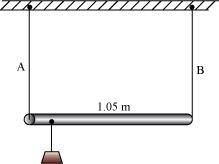
Answer:
Answer: (a) 0.7 m from the steel-wire end
(b) 0.432 m from the steel-wire end
Cross-sectional area of wire A, a1 = 1.0 mm2 = 1.0 × 10–6 m2
Cross-sectional area of wire B, a2 = 2.0 mm2 = 2.0 × 10–6 m2
Young’s modulus for steel, Y1 = 2 × 1011 Nm–2
Young’s modulus for aluminium, Y2 = 7.0 ×1010 Nm–2
(a) Let a small mass m be suspended to the rod at a distance y from the end where wire A is attached.

If the two wires have equal stresses, then:

Where,
F1 = Force exerted on the steel wire
F2 = Force exerted on the aluminum wire

The situation is shown in the following figure.
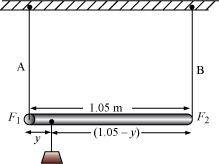
Taking torque about the point of suspension, we have:
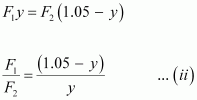
Using equations (i) and (ii), we can write:
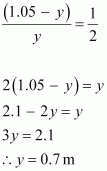
In order to produce an equal stress in the two wires, the mass should be suspended at a distance of 0.7 m from the end where wire A is attached.
(b) 

If the strain in the two wires is equal, then:
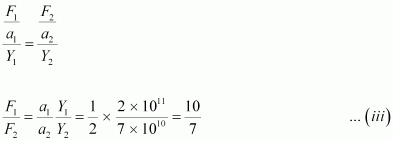
Taking torque about the point where mass m, is suspended at a distance y1 from the side where wire A attached, we get:
F1y1 = F2 (1.05 – y1)
 … (iii)
… (iii)
Using equations (iii) and (iv), we get:
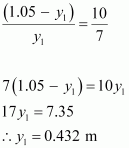
In order to produce an equal strain in the two wires, the mass should be suspended at a distance of 0.432 m from the end where wire A is attached.
Question 9.19:
A mild steel wire of length 1.0 m and cross-sectional area 0.50 × 10–2 cm2 is stretched, well within its elastic limit, horizontally between two pillars. A mass of 100 g is suspended from the mid-point of the wire. Calculate the depression at the midpoint.
Answer:

Length of the steel wire = 1.0 m
Area of cross-section, A = 0.50 × 10–2 cm2 = 0.50 × 10–6 m2
A mass 100 g is suspended from its midpoint.
m = 100 g = 0.1 kg
Hence, the wire dips, as shown in the given figure.
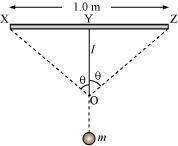
Original length = XZ
Depression = l
The length after mass m, is attached to the wire = XO + OZ
Increase in the length of the wire:
Δl = (XO + OZ) – XZ
Where,
XO = OZ = 
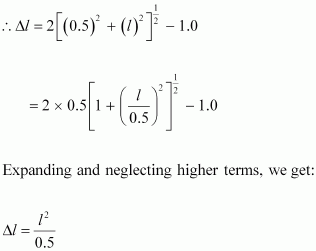

Let T be the tension in the wire.
∴mg = 2T cosθ
Using the figure, it can be written as:
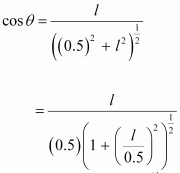
Expanding the expression and eliminating the higher terms:
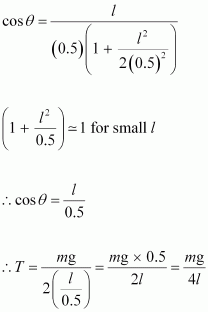
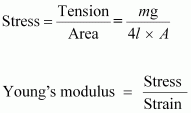

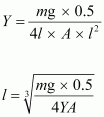
Young’s modulus of steel, Y =

Hence, the depression at the midpoint is 0.0106 m.
Question 9.20:
Two strips of metal are riveted together at their ends by four rivets, each of diameter 6.0 mm. What is the maximum tension that can be exerted by the riveted strip if the shearing stress on the rivet is not to exceed 6.9 × 107 Pa? Assume that each rivet is to carry one quarter of the load.
Answer:
Diameter of the metal strip, d = 6.0 mm = 6.0 × 10–3 m

Maximum shearing stress = 6.9 × 107 Pa

Maximum force = Maximum stress × Area
= 6.9 × 107 × π × (r) 2
= 6.9 × 107 × π × (3 ×10–3)2
= 1949.94 N
Each rivet carries one quarter of the load.
∴ Maximum tension on each rivet = 4 × 1949.94 = 7799.76 N
Question 9.21:
The Marina trench is located in the Pacific Ocean, and at one place it is nearly eleven km beneath the surface of water. The water pressure at the bottom of the trench is about 1.1 × 108 Pa. A steel ball of initial volume 0.32 m3 is dropped into the ocean and falls to the bottom of the trench. What is the change in the volume of the ball when it reaches to the bottom?
Answer:
Water pressure at the bottom, p = 1.1 × 108 Pa
Initial volume of the steel ball, V = 0.32 m3
Bulk modulus of steel, B = 1.6 × 1011 Nm–2
The ball falls at the bottom of the Pacific Ocean, which is 11 km beneath the surface.
Let the change in the volume of the ball on reaching the bottom of the trench be ΔV.
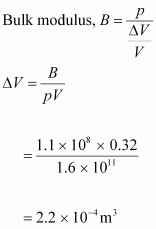
Therefore, the change in volume of the ball on reaching the bottom of the trench is 2.2 × 10–4 m3.
Also Read : INTRODUCTION-Chapter-10-Mechanical-Properties-Of-Fluids-class-11-ncert-solutions-Physics
